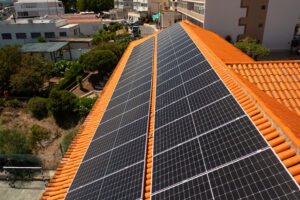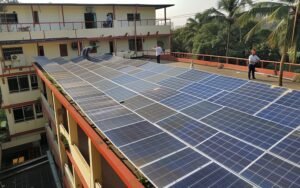Introduction: The Rising Cost of Electricity in India
Electricity prices in India have been steadily increasing over the past few years, and both households and businesses are feeling the impact. From air conditioning units to industrial equipment, our dependence on electricity is only growing.
But there’s good news: Solar power offers a clean, cost-effective, and sustainable alternative. By installing solar panels, Indian homeowners and businesses can cut electricity bills by up to 80%, sometimes even more.
Let’s explore how this works, why solar energy is such a wise investment, and how you can start saving today.
Whether you’re a homeowner or a business owner, solar energy is the most intelligent decision for your pocket and for the planet.

1. How Solar Power Works: Simple Yet Powerful
Solar panels, made up of photovoltaic (PV) cells, convert sunlight into direct current (DC) electricity. An inverter then transforms this DC into alternating current (AC), which powers your home or office appliances.
When your solar system generates more energy than you consume, the extra power is sent back to the electricity grid, a process called net metering. You earn credits for this excess electricity, which further reduces your bill during months when consumption is higher.
This means every unit of sunlight you capture directly translates into units of savings on your electricity meter.
2. The Real Savings: How Solar Cuts Electricity Costs
Here’s where solar really shines: it turns sunlight into savings.
Once you install solar panels, the sunlight you use is entirely free. The only costs you’ll have are your initial installation and occasional maintenance.
Here’s a quick example:
-
- Average monthly electricity bill: ₹5,000
-
- Solar energy covers ~80% of your power use.
-
- New electricity bill: around ₹1,000 per month
That’s ₹48,000 saved per year, and over 25 years, you could save ₹12 lakh or more, depending on your system size and local tariffs.
3. Government Subsidies Make Solar Even More Affordable
The Government of India, under the Ministry of New and Renewable Energy (MNRE), provides generous subsidies to promote residential solar adoption.
-
- 40% subsidy for rooftop solar systems up to 3 kW capacity
-
- 20% subsidy for systems between 3 kW and 10 kW
-
- Incentives for housing societies and small commercial users
-
- Easy registration under the PM Surya Ghar: Muft Bijli Yojana
- Easy registration under the PM Surya Ghar: Muft Bijli Yojana
These subsidies can reduce your upfront installation cost dramatically, allowing homeowners to achieve faster returns on investment.
4. Net Metering: Earn Credits from Your Excess Energy
Net metering is a key reason why solar energy users save so much. When your solar system generates more power than you consume – for example, during daytime hours, the extra electricity is exported to the grid.
Your electricity provider then gives you credit units for that energy. These credits are automatically adjusted in your next bill, reducing what you owe.
This system ensures that every ray of sunlight benefits you, whether you use it immediately or later.

5. Residential vs. Commercial Solar Benefits
For Residential:
-
- Reduction in household electricity bills by 70–80%
-
- 25+ years of reliable performance
-
- Minimal maintenance, just occasional cleaning
-
- Increased property value due to sustainable upgrades
For Commercial:
-
- Substantial operational cost savings
-
- Depreciation benefits under Indian tax laws
-
- Improved corporate image and ESG compliance
-
- Reliable power during peak consumption hours
Factories, warehouses, hospitals, and schools across India are adopting solar to reduce energy costs and carbon footprints simultaneously.
6. Additional Financial Advantages
Zero or Low EMI Financing Options
Many banks and NBFCs now offer solar loans or easy EMI plans, making solar energy accessible for everyone.
Low Maintenance Costs
Solar systems require little upkeep, just periodic cleaning and occasional servicing to ensure optimal performance.
Increased Property Value
Homes with solar installations are seen as more modern and energy-efficient, often increasing resale value.

7. Environmental Benefits: Save the Planet While You Save Money
Switching to solar isn’t just about financial savings it’s also a step toward a cleaner, greener India.
Each 1 kW solar system can offset roughly 1.5 tonnes of CO₂ emissions every year, equivalent to planting 25 trees annually.
By adopting solar energy, you contribute to India’s renewable energy goals under Mission 500 GW by 2030.
8. The Long-Term Return on Investment (ROI)
A typical solar system pays for itself within 4–6 years, after which you enjoy nearly free electricity for another 15–20 years.
Think of it as pre-paying your future energy bills, while protecting yourself from future tariff hikes.
Over time, your savings multiply making solar one of the most profitable and reliable energy investments available today.
Conclusion
Electricity prices will continue to rise, but your savings don’t have to shrink. By switching to solar energy, you can cut your electricity bills by up to 80%, protect yourself from tariff increases, and embrace a cleaner way of living.
Whether you’re a homeowner or a business owner, solar energy is the most intelligent decision for your pocket and for the planet
